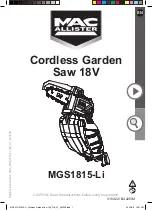
38
39
38
39
9. Never pull the piece back when the
blade is turning. Turn the switch Off.
When the blade completely stops,
you can then remove the workpiece.
Never attempt to pull the workpiece
backwards during a cutting operation.
This will cause kickback and serious
injury to the user can occur. When
the blade completely stops, raise the
anti-kickback pawls assembly (7) on
each side of the riving knife and slide
the workpiece out. (Fig. OO)
BEVEL RIPPING
This cut is the same as ripping except
the blade bevel angle is set to an angle
other than 0°.
RIPPING SMALL PIECES
To avoid injury from blade contact,
never make cuts narrower than
3/4 in. wide.
1. It is unsafe to rip small pieces.
Instead, rip a larger piece to obtain
the size of the desired piece.
2. When a small width is to be ripped,
and your hand cannot be safely
put between the blade and the rip
fence, use push stick or push block
to pass the workpiece completely
through and past the blade.
HELPFUL DEVICES
In order to make some cuts, it is
necessary to use devices like a push
block, featherboard or auxiliary fence,
which you can make yourself. Here are
some templates for your reference.
WARNING
!
FEATHERBOARD (FIG. PP, QQ)
A featherboard is a device used to
help control the workpiece by guiding
it securely against the table or fence.
Featherboards are especially useful
when ripping small workpieces and for
completing non-through cuts.
The end is angled with a number of
short kerfs to give a friction hold on the
workpiece and locked in place on the
table with C-clamps. Test that it can
resist kickback.
Place the featherboard against the
uncut portion of the workpiece to
avoid kickback that could cause
serious personal injury.
MAKE A FEATHERBOARD (FIG. PP)
Select a solid piece of lumber
approximately 3/4 in. thick, 4 in. wide
and 18 in. long. To make a featherboard,
cut one end of the lumber at 60 degrees,
then cut 8 in. long slots 1/4 in. apart on
the angled end as shown in Fig. PP.
WARNING
!
4 in.
1/8 in.
3/4 in.
2.3 in.
8 in.
18 in.
60
o
Fig. PP
















































